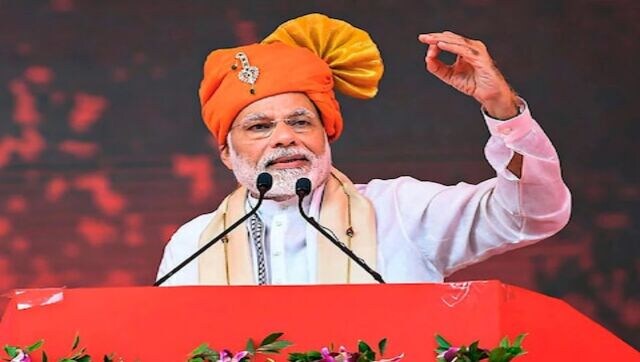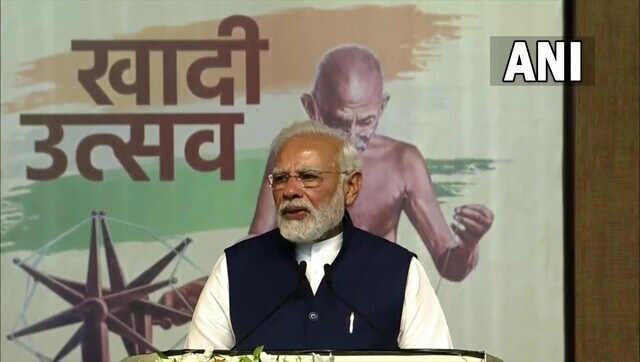Beneath his hardline image, a ‘soft’ Narendra Modi is at work
His opponents’ biggest grouse is that Modi is the worst thing that has happened to minorities in India. Government statistics don’t bear that out

Prime Minister Narendra Modi. News18
Even the thought makes his core support base bristle. It sends his detractors in denial. But beneath the nationally and internationally curated image of a hard, ruthless and majoritarian Narendra Modi exists a truth inconvenient for many.
There exists, quite demonstrably, a soft and inclusive Narendra Modi.
Beyond the spiel and stereotype lie certain facts. Policies and actions testify to a prime minister who does not polarise and instead unsentimentally and without discrimination provides for key markers liberals and socialists value like minorities, backward castes, tribals, unorganised labour and rural homemakers.
Straight up, schemes like Jan Dhan or opening bank accounts for the poor, Ujjwala or cooking gas for low-income households, Saubhagya or universal electrical, toilets under Swachh Bharat, or health insurance under Ayushman Bharat have benefited hundreds of millions without asking them their religion, caste, age or gender. Of the 46.11 crore Jan Dhan beneficiaries till 27 July, 2022, 25.64 crore are women.
His opponents’ biggest grouse is that Modi is the worst thing that has happened to minorities in India. Government statistics don’t bear that out.
The Ministry of Minority Affairs got Rs 4,810.77 crore in the 2021-22 Union Budget, Rs 805.77 crore more than the revised figures for the previous fiscal. The ministry’s budget has increased by Rs 1,300 crore in the last six years.
In July 2019, Parliament scrapped instant triple talaq by adopting the Muslim Women (Protection of Rights on Marriage) Bill, fulfilling Modi’s election promise.
A month before that, the Modi government announced scholarships to five crore students over five years, 50 per cent of the endowments meant for girls. In the first six months of Modi 2.0, scholarships were sanctioned to more than 80 lakh Jain, Parsi, Buddhist, Christian, Sikh and Muslim students, of which 60 per cent are girls. Besides that, in 2019, 3 lakh poor and needy girls were given the Begum Hazrat Mahal Scholarship.
The government has been trying to bring to the mainstream madrassas, many of which have contributed to Islamist fundamentalism. Over 750 madrassa teachers were trained, including many women. More than 650 school dropouts were given bridge courses.
So far, more than 2.5 lakh minority youth have been imparted employable skill development schemes such as Garib Nawaz Rozgar Yojana, Seekho Aur Kamao, Nai Manzil, Ustad, Nai Roshni and Hunar Haat.
From Unani Colleges and girls’ hostels to a Haj portal and app, digitisation of Waqf records to the Kartarpur corridor and rights to Sikh minorities after the abrogation of Article 370 in Jammu and Kashmir, the list is almost boringly long and largely unacknowledged.
On backward castes, for instance, 2.75 crore Dalit youth have benefited from the Mudra scheme, according to the Dalit Indian Chamber of Commerce and Industry. The government in 2015 gave the SC/ST Act more teeth by forcibly shaving one’s head, blackening face, or stopping one from riding a horse punishable under it.
Across the nation, the BJP now has the highest number of Dalit MPs, MLAs, councillors, village and district-level leaders. The previous President of India, Ram Nath Kovind, was a Dalit. There are 12 Dalit ministers in the Union government.
Modi’s strongest tribal outreach, at least the signalling, has been appointing Draupadi Murmu as president. But a fair bit of policy action goes on in the backdrop too.
In the 2022-2023 Budget, Rs 8,451.92 crore has been allocated for the Ministry of Tribal Affairs, which is about 12.32 per cent more than the previous budget. Rs 3,344 crore has been given under central schemes like the National Tribal Welfare Programme, Rs 26,135 crore under the Pradhan Mantri Van Bandhu Kalyan Yojana, and 2,000 crore for Eklavya Schools.
The Modi government has set aside Rs 28,920 crore in the 15th Finance Commission cycle to set up 452 new schools, upgrading existing 211 schools and building 15 sports centres.
New Haat Bazaars and Storehouses will be developed in the next five years as part of “Atmanirbhar Bharat Abhiyan”. TRIFED will be the nodal agency to implement this scheme. The products will be marketed through Tribe India stores. For the mission, an amount of Rs 1612 crore has been earmarked over the next five years.
Rs 50 crore has been approved for Venture Capital Fund for Scheduled Tribes (VCF-ST). A tribal entrepreneurship scheme for the Northeast named Transportation, Maintenance and Marketing of Tribal Products in the North-Eastern Region has been approved, Rs 75 crore earmarked for it this year.
That list again is quite long.
All this could be a reason why the relentless narrative of Modi as an anti-minority, anti-SC/ST leader does not wash on the ground. He has been winning elections on the back of some of these social groups and communities, and has managed to radically alter the BJP’s ‘Brahmin-Bania’ image.
That makes him immune to narrative devoid of facts.
Read all the Latest News, Trending News, Cricket News, Bollywood News,
India News and Entertainment News here. Follow us on Facebook, Twitter and Instagram.
also read

PM Modi discusses climate finance with Norwegian counterpart Jonas Gahr Store
The two leaders reviewed various ongoing bilateral cooperation initiatives, including under the Task Force on blue economy, the Ministry of External Affairs said in a statement

India becoming world's fifth largest economy no ordinary feat, every Indian proud of it, says PM Modi
Prime Minister Narendra Modi on Thursday virtually addressed beneficiaries of various government schemes and those present at a mega medical camp organised in Olpad area of Surat city in Gujarat, where the Assembly polls are due later this year

Happy Birthday Narendra Modi: Five trivia about the leader
Since taking charge, PM Modi has stressed achieving self-reliance or AatmaNirbhar Bharat in all senses. He has a firm belief that self-reliance can help bring India on par with other more developed nations